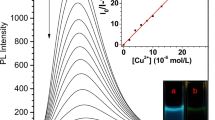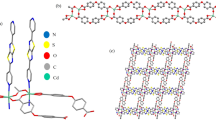Abstract
The synthesis of N-cyclohexyl carbamate-attached fluorene-alt-phenylene copolymer (PFPNCC) and the use of PFPNCC as a “ligand-free” fluorescent chemosensor for Cu(II) are described. Addition of Cu(II) can efficiently quench the fluorescence of PFPNCC in nucleophilic solvents such as DMF and DMSO, but not in low nucleophilic solvents such as 1,4-dioxane and THF. Ultraviolet-visible spectra of the mixture of the conjugated polymer and Cu(II) indicate the presence of a reduced Cu (I) ion in the solution. Furthermore, fluorescence recovery of PFPNCC observed at low temperature suggests that the quenching and reducing mechanism is most probably due to a photo-induced electron transfer from excited PFPNCC to Cu(II). Our findings provide a novel strategy for highly selective conjugated polymer-based chemosensors for various target analytes, albeit “ligand-free”.

Similar content being viewed by others
References
Liu J, Chakraborty S, Hosseinzadeh P, Yu Y, Tian S, Petrik I, Bhag A, Lu Y. Metalloproteins containing cytochrome, iron-sulfur, or copper redox centers. Chemical Reviews, 2014, 114(8): 4366–4469
Winkler J R, Gray H B. Electron flow through metalloproteins. Chemical Reviews, 2013, 114(7): 3369–3380
Rae T, Schmidt P, Pufahl R, Culotta V, O’halloran T. Undetectable intracellular free copper: The requirement of a copper chaperone for superoxide dismutase. Science, 1999, 284 (5415): 805-808
Vora S R, Guo Y, Stephens D N, Salih E, Vu E D, Kirsch K H, Sonenshein G E, Trackman P C. Characterization of recombinant lysyl oxidase propeptide. Biochemistry, 2010, 49(13): 2962–2972
Kieber-Emmons MT, Qayyum MF, Li Y, Halime Z, Hodgson K O, Hedman B, Karlin K D, Solomon E I. Spectroscopic elucidation of a new heme/copper dioxygen structure type: Implications for O···O bond rupture in cytochrome c oxidase. Angewandte Chemie International Edition, 2012, 51(1): 168–172
Multhaup G, Schlicksupp A, Hesse L, Beher D, Ruppert T, Masters C L, Beyreuther K. The amyloid precursor protein of Alzheimer’s disease in the reduction of copper(II) to copper(I). Science, 1996, 271(5254): 1406–1409
Barnham K J, Bush A I. Metals in Alzheimer’s and Parkinson’s diseases. Current Opinion in Chemical Biology, 2008, 12(2): 222–228
Lee S, Barin G, Ackerman C M, Muchenditsi A, Xu J, Reimer J A, Lutsenko S, Long J R, Chang C J. Copper capture in a thioether-functionalized porous polymer applied to the detection of Wilson’s disease. Journal of the American Chemical Society, 2016, 138(24): 7603–7609
Tanzi R E, Petrukhin K, Chernov I, Pellequer J L,Wasco W, Ross B, Romano D M, Parano E, Pavone L, Brzustowicz L M, et al. The Wilson disease gene is a copper transporting ATPase with homology to the Menkes disease gene. Nature Genetics, 1993, 5(4): 344–350
Shao N, Zhang Y, Cheung S, Yang R, Chan W, Mo T, Li K, Liu F. Copper ion-selective fluorescent sensor based on the inner filter effect using a spiropyran derivative. Analytical Chemistry, 2005, 77 (22): 7294–7303
Shen Q, Zhao X, Zhou S, Hou W, Zhu J J. ZnO/CdS hierarchical nanospheres for photoelectrochemical sensing of Cu2+. Journal of Physical Chemistry C, 2011, 115(36): 17958–17964
Nuevo Ordóñez Y, Montes-Bayón M, Blanco-González E, Sanz-Medel A. Quantitative analysis and simultaneous activity measurements of Cu, Zn-superoxide dismutase in red blood cells by HPLCICPMS. Analytical Chemistry, 2010, 82(6): 2387–2394
Yang L, Lian C, Li X, Han Y, Yang L, Cai T, Shao C. Highly selective bifunctional luminescent sensor toward nitrobenzene and Cu2+ ion based on microporous metal-organic frameworks: Synthesis, structures, and properties. ACS Applied Materials & Interfaces, 2017, 9(20): 17208–17217
Han Y, Ding C, Zhou J, Tian Y. Single probe for imaging and biosensing of pH, Cu2+ ions, and pH/Cu2+ in live cells with ratiometric fluorescence signals. Analytical Chemistry, 2015, 87 (10): 5333–5339
Yun S H, Xia L, Edison T N, Pandurangan M, Kim D H, Kim S H, Lee Y R. Highly selective fluorescence turn-on sensor for Cu2+ ions and its application in confocal imaging of living cells. Sensors and Actuators. B, Chemical, 2017, 240: 988–995
Hsieh Y C, Chir J L, Wu H H, Guo C Q, Wu A T. Synthesis of a sugar-aza-crown ether-based cavitand as a selective fluorescent chemosensor for Cu2+ ion. Tetrahedron Letters, 2010, 51(1): 109–111
Kim H N, Guo Z, Zhu W, Yoon J, Tian H. Recent progress on polymer-based fluorescent and colorimetric chemosensors. Chemical Society Reviews, 2011, 40(1): 79–93
McQuade D T, Pullen A E, Swager T M. Conjugated polymer-based chemical sensors. Chemical Reviews, 2000, 100(7): 2537–2574
Álvarez-Diaz A, Salinas-Castillo A, Camprubí-Robles M, Costa-Fernández J M, Pereiro R, Mallavia R, Sanz-Medel A. Conjugated polymer microspheres for “turn-off”/“turn-on” fluorescence optosensing of inorganic ions in aqueous media. Analytical Chemistry, 2011, 83(7): 2712–2718
Dong Y, Koken B, Ma X, Wang L, Cheng Y, Zhu C. Polymer-based fluorescent sensor incorporating 2,2′-bipyridyl and benzo[2,1,3] thiadiazole moieties for Cu2+ detection. Inorganic Chemistry Communications, 2011, 14(11): 1719–1722
Xing C, Shi Z, Yu M, Wang S. Cationic conjugated polyelectrolyte-based fluorometric detection of copper (II) ions in aqueous solution. Polymer, 2008, 49(11): 2698–2703
Jeong Y, Yoon J. Recent progress on fluorescent chemosensors for metal ions. Inorganica Chimica Acta, 2012, 381: 2–14
Kaur B, Kaur N, Kumar S. Colorimetric metal ion sensors—a comprehensive review of the years 2011–2016. Coordination Chemistry Reviews, 2018, 358: 13–69
Duraisamy U, Naha S, Sivan V. Colorimetric and fluorescent chemosensors for Cu2+. A comprehensive review from the years 2013–15. Analytical Methods, 2017, 9: 552–578
Pu K, Fang Z, Liu B. Effect of charge density on energy-transfer properties of cationic conjugated polymers. Advanced Functional Materials, 2008, 18(8): 1321–1328
Sun P, Lin M, Zhao Y, Chen G, Jiang M. Stereoisomerism effect on sugar-lectin binding of self-assembled glyco-nanoparticles of linear and brush copolymers. Colloids and Surfaces. B, Biointerfaces, 2015, 133: 12–18
Franc G, Jutand A. On the origin of copper (I) catalysts from copper (II) precursors in C-N and C-O cross-couplings. Dalton Transactions (Cambridge, England), 2010, 39(34): 7873–7875
Valeur B, Leray I. Design principles of fluorescent molecular sensors for cation recognition. Coordination Chemistry Reviews, 2000, 205(1): 3–40
De Santis G, Fabbrizzi L, Licchelli M, Mangano C, Sacchi D, Sardone N. A fluorescent chemosensor for the copper (II) ion. Inorganica Chimica Acta, 1997, 257(1): 69–76
Rehm D, Weller A. Kinetics of fluorescence quenching by electron and H-atom transfer. Israel Journal of Chemistry, 1970, 8(2): 259–271
Yang G, Wang W, Wang M, Liu T. Side-chain effect on the structural evolution and properties of poly(9,9-dihexylfluorene-alt-2,5-dialkoxybenzene) copolymers. Journal of Physical Chemistry B, 2007, 111(27): 7747–7755
Richardson K A. The manufacture of high temperature superconducting tapes and films. Universal-Publishers, 1999, 4: 26–27
Verma M, Chaudhry A F, Fahrni C J. Predicting the photo-induced electron transfer thermodynamics in polyfluorinated 1,3,5-triarylpyrazolines based on multiple linear free energy relationships. Organic & Biomolecular Chemistry, 2009, 7(8): 1536–1546
Liu Y, Minami T, Nishiyabu R, Wang Z, Anzenbacher P. Sensing of carboxylate drugs in urine by a supramolecular sensor array. Journal of the American Chemical Society, 2013, 135(20): 7705–7712
Minami T, Liu Y, Akdeniz A, Koutnik P, Esipenko N A, Nishiyabu R, Kubo Y, Anzenbacher P. Intramolecular indicator displacement assay for anions: supramolecular sensor for glyphosate. Journal of the American Chemical Society, 2014, 136(32): 11396–11401
Acknowledgements
This work was financially supported by the National Basic Research Program of China (Grant No. 2015CB932200), the National Natural Science Foundation of China (Grant Nos. 21604042, 61378081, 21574064, and 21674048), Synergetic Innovation Center for Organic Electronics and Information Displays, Jiangsu National Synergetic Innovation Center for Advanced Materials, the Natural Science Foundation of Jiangsu Province of China (No. BK20150843), NUPTSF (Nos. NY215017, NY211003, and NY215080) and the Innovation Program for Postgraduates Research of Colleges and Universities of Jiangsu Province (No. CXZZ12-0459).
Author information
Authors and Affiliations
Corresponding authors
Electronic supplementary material
Rights and permissions
About this article
Cite this article
Deng, W., Sun, P., Fan, Q. et al. Highly selective detection of copper(II) by a “ligand-free” conjugated copolymer in nucleophilic solvents. Front. Chem. Sci. Eng. 14, 105–111 (2020). https://doi.org/10.1007/s11705-019-1791-6
Received:
Accepted:
Published:
Issue Date:
DOI: https://doi.org/10.1007/s11705-019-1791-6




